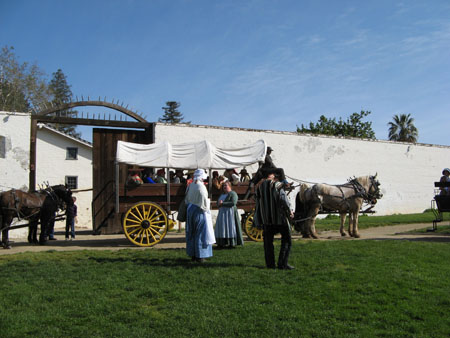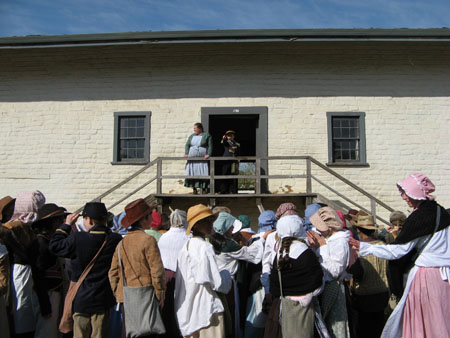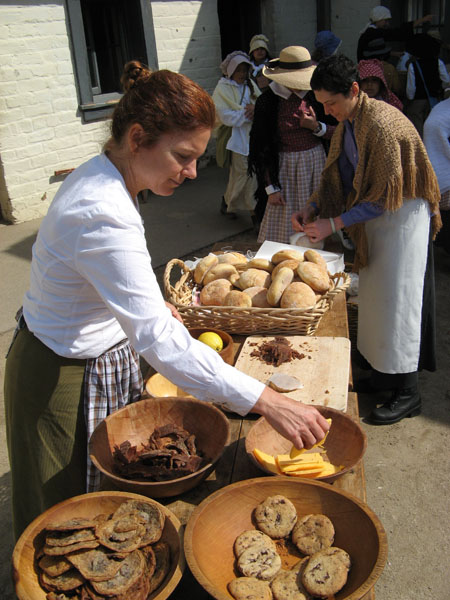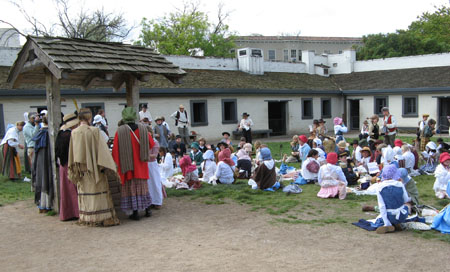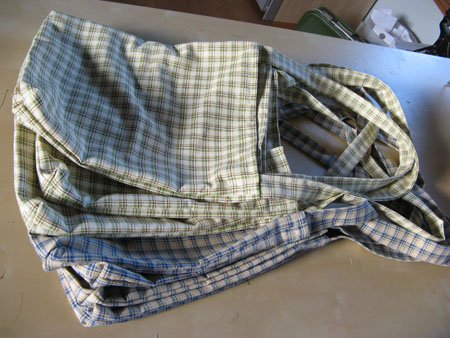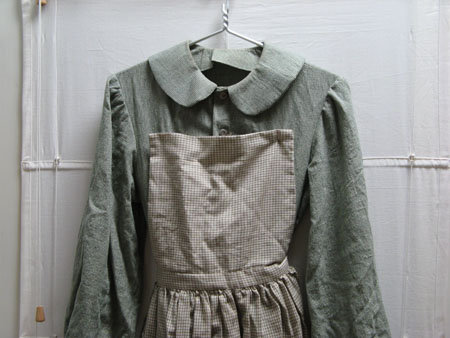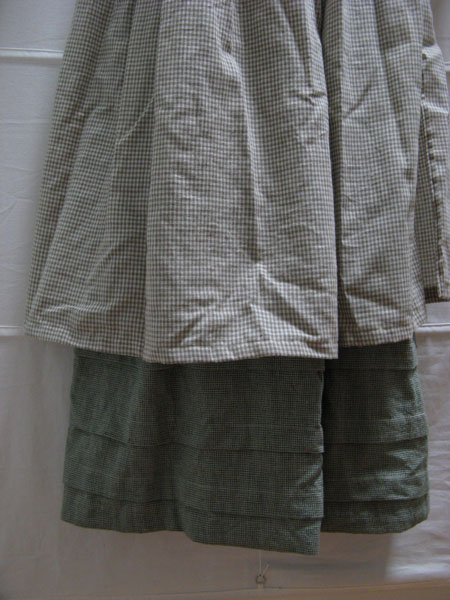Whew. We made it. Our trip to Sutter’s Fort was challenging, incredibly fun, and thankfully over without a hitch.
I can just hear all those pioneers from the 1840’s laughing. “You call that a hard day?” they’re saying. “Shoot. You don’t know a hard day from a hog’s beard.” (Now they’re laughing even harder. “Hog’s beard?? What the Sam Hill is that?!”) So fine, I’ll amend my statement. It wasn’t that hard, in the scheme of hard. But I was very sleepy when I got home.
We dropped the kids off at school at 6:45 am. They rode up to Sacramento in buses while we drove with all the supplies. I was on the kitchen crew, so when we got up to Sutter’s Fort, we brought in all the food, inventoried the kitchens, and set everything up for the day. Meanwhile, the kids all went to the train museum in historic Sacramento and traded in the buses for horse-drawn wagons, which pulled them through the city streets to the fort. When they arrived, all the parents went out to greet them. We were allowed to take a few photos as they rolled in, and here’s a glimpse:
There were actually five wagons of kids.
Once inside the fort, there was a brief welcome by John Sutter (played by one of Honey’s classmates), and then we all got to work.
I have very few photos of the day – partly because they didn’t want us to break the time period by walking around with cameras, and partly because we were pretty much working the whole time. The students rotated through stations where they participated in activities that were standard fare in the fort while it was active. At each station, parents would give them a bit of history, demonstrate the activity and give them some work to do – the stations were baking, spinning & weaving, laundry, animal care, corn husk dolls, kitchen, trapping, carpentry, trade store, vaqueros, candle-making, blacksmith and covered wagon. All of the parents had been trained at the fort so they could not only teach our students, but act as the fort’s docents for all the other visitors as well. (There were only a couple of stations with docents that were not parents from our school – the blacksmith and the main animal care docent.) That day, there were four other school groups visiting, so there was plenty of foot traffic.
In the kitchen, we had lunch and dinner to prepare for 150 people. Let’s just say that by the end of the day, we all had a healthy respect for the cooks of the time. Our lunch was a simple, ploughman-style deal wrapped up in waxed paper, since we didn’t all sit down for that meal. Here are two of my beautiful friends working on the lunch assembly line:
We had to be sure that any containers we used were at least possible for the time period, so all serving bowls had to be wood or metal, and the waxed paper was all torn into lengths out of sight in the ‘modern’ kitchen that we could use for washing up. The first groups of kids helped us wash apples, slice cheese and wrap lunches. Just before noon, they all assembled on the lawn and ate during mail call.
After lunch, we went into full dinner prep. I wish I’d had time to take some photos of the period kitchen to show you the fireplace in action – hopefully I’ll be able to grab a shot or two from the parents who were assigned to document the day. You can see one shot of the kitchen on the Sutter’s Fort State Park website, and it gives you a bit of a glimpse – all along the back wall are the fabulous cast iron pots and dutch ovens we got to use to prep the dinner. What you don’t see is the fireplace where we got to hang those pots on massive iron swing arms and surround the dutch oven with the coals from the (wood) fire. After being away from a hotshop for so many years, I have to admit it was great to be back in the heat!
Of course, where there’s fire, there also has to be some serious respect. Particularly when your Environmental Learning Program training materials contain sentences like this one:
“Hearth injuries were second only to childbearing (birthing babies) as the leading cause of death in women.”
Okay then! Good to know! We all learned how to tuck our skirts between our knees when moving the pots around in the fireplace or on the spit outside, just to make sure our hems didn’t start smoldering. But lifting those big old pots, swaying with water and carrots or beans, with iron hooks and sliding them onto the spit, or in among the coals… seriously, it was awesome. And the dinner! It was amazing too. The kids filled their plates at long tables covered with cucumber salad, freshly baked bread and churned butter, grilled chicken, ribs and salmon, black beans, pinto beans, carrots caramelized by a long slow cook in the fire, and mashed potatoes. This was all followed by apple cake and cream whipped by hand. It was delicious.
After dinner, the kids learned some folk dances and songs from a team called The Amazing Harmonatras – folk musicians who teach history through music. I thought my Uncle George would have like hearing that part! The kids learned a few Gold Rush folk songs and even galloped through a couple of line dances before settling in to hear some stories. I wish I could have heard more of that part of the performance, but we were all cleaning up like mad to meet our end-of-day deadline. We weren’t sure what exactly would happen to us if we ran past our end time, but we knew it wouldn’t be pretty. Everything had to be cleaned, cast iron oiled, utensils carefully put back in place and two kitchens inventoried before we got the green light to close up shop for the day. It had to be perfect, and thanks to all the volunteers who washed and cleaned, it was. Turns out that many hands might not always make light work, exactly, but they certainly can get the work done. And how. Looks like we’ll get to come back next year.
Oh and in case you’re wondering – all the sewing did get done. A group of parents sewed 95 bags for students and volunteers to use for their supplies – a batch of mine looked like this:
And my dress actually came out. I don’t have pictures of it on (thank heavens) – but here it is the next day:
A little ragged, and smelling of smoke from the fires, but still in one piece.
So there you have it. Now, if you’re ever just dying to know something about Sutter’s Fort, 1840’s California cookery, or if you simply have a need for a fetching pioneer frock, I’m your gal.
